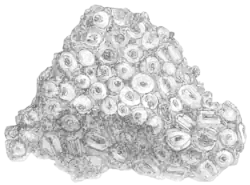332
ILLUSTRATIONS OF THE CONNEXION
discovery of a large iron nail in the centre of a flint which he had accidentally broken. I immediately rode a distance of some twenty miles to inspect this "wonderful curiosity," and was not a little surprised to find my correspondent's statement apparently borne out; for he placed in my hands a large rolled stone, closely resembling externally the usual flint boulders of the ploughed lands of chalk districts, and which had been split down the middle; on one side was imbedded a large iron nail, and deeply impressed on the opposite surface the corresponding mould. A slight inspection detected the nature of this specimen: it was not a flint, but an aggregation of fine siliceous sand that had been converted into compact sandstone by a solution of iron derived from the nail, which had served as a nucleus to the sand that had gradually accumulated around it. The facts described by Kirwan and Knight doubtless admit of the same explanation; the narrators having mistaken a sandstone of modern formation for a genuine flint nodule. When residing at Brighton, I obtained many specimens of recent ironstone from the fishermen, who dredged them up from the British Channel. Cannon-balls, horse-shoes, nails, chains, fragments of bolts, bars, anchors, &c., formed the nuclei of these masses; some of which were exceedingly interesting from the variety of shells, zoophytes, and other marine productions promiscuously impacted in the same block of stone.[1]
I have here a specimen which has puzzled many a geologist.

Ferruginous Conglomerate of beads and knife-blades.
It is a ferruoinous conglomerate of glass beads and sand; it was obtained a few years since from a Dutch vessel, laden with beads, knives, &c., that was stranded off the Sussex coast, near Hastings, about a century ago, and wholly covered by a thick bed of silt
- ↑ The cement of the shell-conglomerate now rapidly forming in the bed of the sea off Brighton is also ferruginous. See Medals of Creation, Vol. I, p. 374.